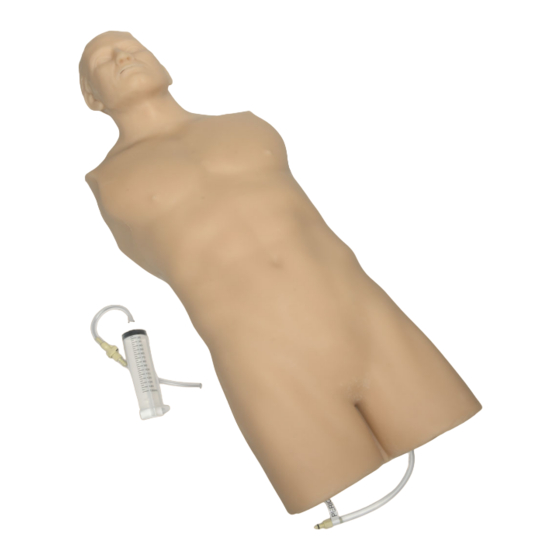
Table of Contents
Advertisement
Quick Links
Advertisement
Table of Contents

Summary of Contents for CAE Blue Phantom FAST Exam Ultrasound Training Model
-
Page 3: Table Of Contents
Removing Air ...............15 ©2022 CAE 905K004752 v1.0... - Page 4 Contents THIS PAGE INTENTIONALLY LEFT BLANK ©2022 CAE 905K004752 v1.0...
-
Page 5: Cautions And Warnings
Cautions and Warnings Cautions and Warnings Read this user guide, including all cautions and warnings, before you use your CAE Blue Phantom™ ultrasound training model. Use this product only as described in this guide. If you use the product incorrectly, it may be unsafe and will void your warranty. Keep this information for future reference. -
Page 6: Fluids System
Cautions and Warnings Fluids System • Use only CAE Blue Phantom fluids. Other fluids can affect the imaging quality and promote fungal or bacterial growth, and may void your warranty. Use fluids only as directed. • Do not substitute any other fluid unless indicated by this guide. -
Page 7: Introduction
Introduction This user guide describes the features, use, and care of the following training models: • CAE Blue Phantom FAST Exam Ultrasound Training Model, transthoracic only (BPFAST1800) • CAE Blue Phantom FAST Exam Ultrasound Training Model, transesophageal (BPFAST1802) • CAE Blue Phantom Echocardiography and Pericardiocentesis Ultrasound Training Model, transthoracic only (BPTTE1701-HEAD) •... -
Page 8: Anatomy
Introduction Anatomy CAE Blue Phantom training models are constructed using our patented Simulex™ ultrasound tissue which has imaging characteristics that mimic human tissue. The models contain skeletal components so the user will encounter the same imaging landmarks as in a human patient. -
Page 9: Equipment Overview
CAE Blue Phantom training models are compatible with any diagnostic ultrasound system. General frequency ranges for diagnostic ultrasound imaging are 2-20MHz. Optional accessories or consumables for your model are available to purchase on the CAE website: • BRS180-RED Red ultrasound refill fluid •... - Page 10 Introduction THIS PAGE INTENTIONALLY LEFT BLANK ©2022 CAE 905K004752 v1.0...
-
Page 11: Using The Training Model
Setup Follow the guidelines below to unpack and set up your CAE Blue Phantom training model. 1. Open the shipping carton: Use extreme caution with sharp tools, such as a box cutter, to avoid damage to the training º... - Page 12 Method B: Quick-Fill port for high volume use 1. Connect an IV bag containing CAE Blue Phantom fluid to the fill tube. 2. Hang the IV bag no more than 12 inches (30 cm) above the training model to avoid overfilling.
-
Page 13: Training
This section provides information about using your model for training and practice. Ultrasound Scanning Note: CAE Blue Phantom products do not teach ultrasound procedures or techniques. Refer to your institution or training program for more information. To scan with your training model and conduct a simulated ultrasound-guided procedure: 1. - Page 14 To end the procedure, verify that all rotary controls are in a neutral and unlocked position, then slowly withdraw the transducer. Ultrasound-Guided Procedures Your CAE Blue Phantom training model is a realistic platform for pericardiocentesis procedural training. Use your normal protocol and equipment for these procedures, and follow the policies and guidelines of your institution.
- Page 15 Do not inject air into the heart or the pericardium because air will obstruct imaging. If air enters the system, it must be removed. To do this, see the Troubleshooting section of this user guide. ©2022 CAE 905K004752 v1.0...
- Page 16 Using the Training Model THIS PAGE INTENTIONALLY LEFT BLANK ©2022 CAE 905K004752 v1.0...
-
Page 17: Care And Maintenance
• Storage temperature degree range: 45 to 85 °F (7 to 29 °C) • Store the model as is, or in a CAE Blue Phantom storage case (if available for your model). • Do not store in contact with other models or hard objects as the pressure can damage the Simulex tissue. -
Page 18: Cleaning The Esophagus (Tee/Toe Models)
This section provides information to identify and fix problems that may occur with the product. Fluid Overfill You can overfill fluid spaces and vessels if you inject too much fluid. Overfill does not usually result in permanent damage, but you should correct it as soon as possible. ©2022 CAE 905K004752 v1.0... -
Page 19: Removing Air
When the effusion is empty, the syringe will be under vacuum. Do not put excessive force on the syringe or the tissue may rupture. 10. If the procedure is not successful, fill the model again with 500 ml of fluid and let it sit overnight. Then repeat the procedure. ©2022 CAE 905K004752 v1.0... - Page 20 Care and Maintenance THIS PAGE INTENTIONALLY LEFT BLANK ©2022 CAE 905K004752 v1.0...












Need help?
Do you have a question about the Blue Phantom FAST Exam Ultrasound Training Model and is the answer not in the manual?
Questions and answers